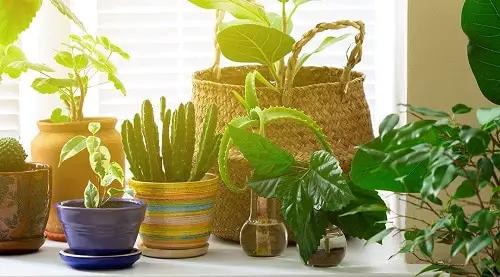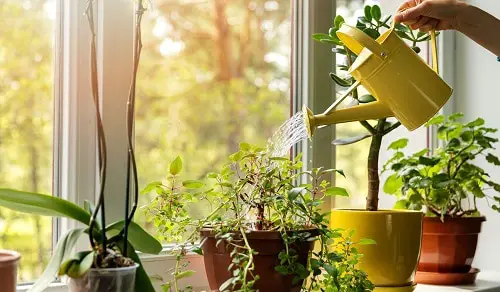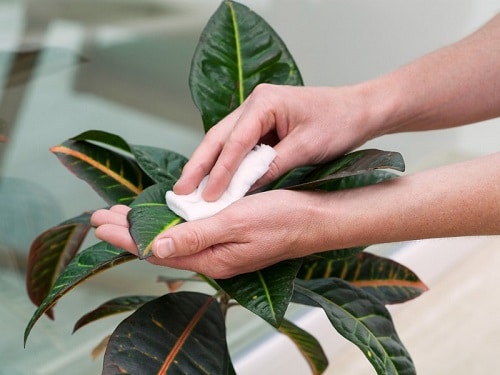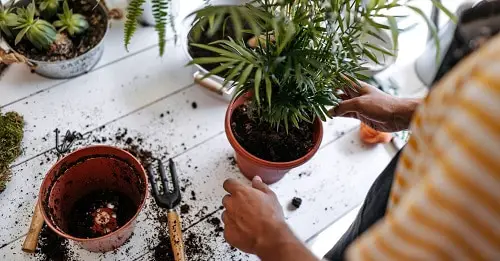Follow this Indoor Plant Care Routine checklist to keep your houseplants healthy and thriving all year round!
The key to flourishing houseplants all year round is maintaining an Indoor Plant Care Routine. For your help, we’re listing things you should do and you should not.
Invest Right
Along with giving time to your plants, you have to spend some money as well. If you want lush and healthy plants, invest in good quality potting mix, fertilizer, containers, and tools to take the right care of them.
Indoor Plant Care Routine – Daily

More Light
Every morning when you wake up, first open the blinds and curtains so your indoor plant can start bathing in light. Also, arrange your plants in a way that provides them enough light throughout the day when you’ll be away from your home for work. When it comes to keeping plants by the window, give priority to light-loving plants.
Misting
If you have humidity-loving plants like peace lily, rubber tree, or fiddle leaf fig, then you can mist their leaves in the morning. Just make sure the weather is warm enough for misting, and they receive enough light and air circulation.
Connect
This is not mandatory, but whenever you find the time–in the morning, afternoon, or evening– spend a few minutes with your plants. Connect to them, caress their leaves. This way, you’ll also be able to discover plant problems like pests and diseases on time.
Check out common indoor plant problems and how to cure them
Weekly Routine

Once a week during the weekend or whenever you get time, dedicate a day to these chores.
Watering
Observe your plants carefully to note which ones need more frequent watering and the ones that only require water every other week. The best way is to poke your finger in the topsoil and check for moisture. If you feel it dry, it’s time to water your plants.
Saturday or Sunday should be the best for a weekly watering check. Most houseplants respond well to a once-in-a-week watering schedule. But, it’s important to note here that ‘how frequently should you water’ also depends on the climate and weather conditions.
A Tip: To make the process easier, create groups of plants according to their watering needs.
Pruning
While watering, keep a pair of gardening sheers with you to trim off dead, dying, and diseased parts of plants every week. Also, remove faded flowers or leaves if you see them. Generally, only a few plants require regular pruning.
Rotation
Indoor plants often bend toward the sun, so keep this task in your weekly work routine. Rotate your plants once a week! Moving your houseplants toward the direction of light ensures all parts receive an ample amount of light evenly.
Shaking
If you have a fiddle leaf plant, then shuddering it lightly will mimic the gust of wind, and this will ensure that it develops a strong root system.
Also, for indoor trees, shaking them gently will make all the loose and dry leaves fall off.
Monthly Routine

Decide a day and start doing these things below every month for happy indoor plants:
Dusting
Indoor plants accumulate some dust on leaves that must be removed timely as it impedes their ability to photosynthesize and affects the plant’s overall health. Give your plants’ leaves a gentle wipe with a damp sponge or soft towel. For dusting succulents and cacti, using compressed air from a distance will be a good idea.
Fertilizing
Feeding your plants monthly with a balanced liquid fertilizer diluted to half of its strength is a good idea. Just make sure that you are not feeding them when you see the symptoms of overfertilization or during the period when they are not actively growing, i.e., winter.
Checking for Pests and Diseases
Look on the undersides of leaves and hidden areas of stem for pests like aphids, mealybugs, and spider mites. You can get rid of them easily using an insecticidal soap solution.
Seasonal Routine

Repotting
If your plants have outgrown their containers, transplant them into one size bigger pot to give them sufficient space to flourish. A few signs that indicate your plants need re-potting are:
- Roots growing out of the container drainage holes.
- The growth of the leaves is substantially slowing down.
Winter Check
Give your plants some extra care in the winter months. Keep them in a warm spot and move them slightly away if they are touching the freezing windowpane to protect them from cold shock.



Paano po ito makasali